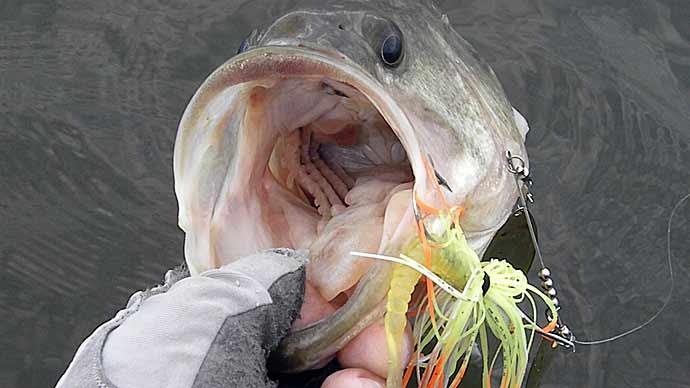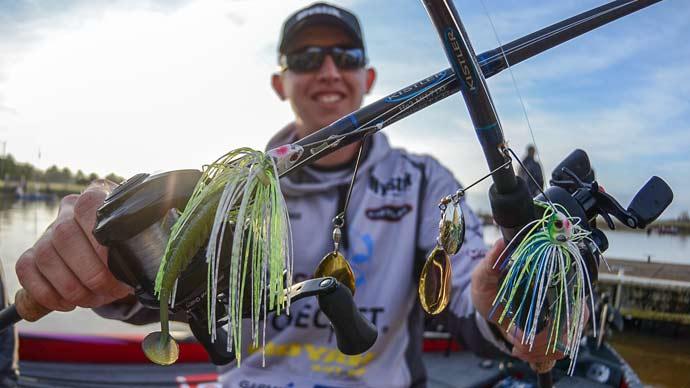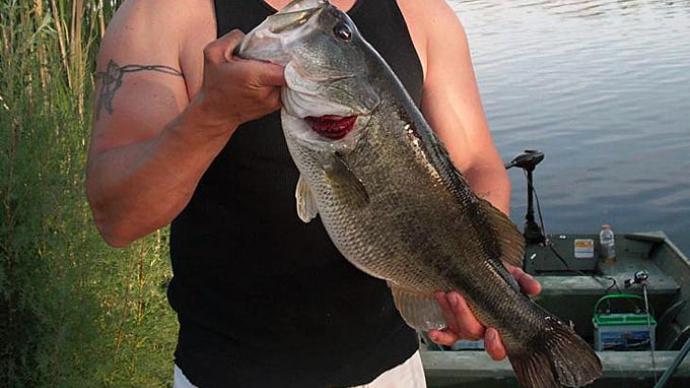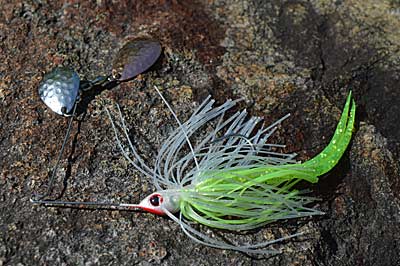
Spring is a season full of changes. Trees bud, grass greens, and water warms as each day brings more daylight. Bass notice that last detail, kicking off a feeding frenzy and pushing to shallow water in preparation for spawning. Bass anglers take notice, too. And spinnerbaits are an excellent way for them to go along for the ride.
A stalwart lure in almost every tackle box, spinnerbaits have been benched by many anglers for the most part. Instead, vibrating jigs, and in some situations, umbrella rigs have replaced them in the starting lineup. But that doesn’t mean spinnerbaits strike out when catching today's bass. On the contrary, plenty fall for their whirling blades and pulsating skirt, including some of the year's biggest. And that's just the beginning of why you should send one to bat in spring.
Spinnerbaits' most significant benefit is their ability to effectively cover vast amounts of water. That's important in spring. Prespawn bass don't stay still for long, moving to shallow spawning flats from deeper wintering holes. And as spring progresses, the weather stabilizes and warms, only accelerating their movements.
But there are more benefits to spinnerbaits. Their bulk and flashy blades take advantage of springtime bass’ aggressive nature. And an almost uncountable number of blade, weight, and color combinations are available, so it's easy to find one that best suits your current fishing situation or the bass' preference, whether matching hatch or mood.
While spinnerbaits can be fished in various spots and ways, two stand out in spring. One deep and one shallow, they help you keep pace with bass during this season of change. Here's how to approach both so that you can catch more and bigger bass.
Braided Line And Double Willows
Before bass find their spawning beds, they congregate on nearby spots with plenty of cover and deeper water. While rock and brush will hold their share, count yourself lucky if your favorite lake, river, or reservoir has submerged aquatic vegetation — a much more common option across the northern half of the United States. Prespawn bass cling to it like iron filings to a magnet. And slow-rolling a spinnerbait is a productive way to extract them.
Water clarity — which controls the amount of sunlight reaching these plants — and how much aquatic vegetation survived the winter determine the size and location of these prespawn spots. You want to locate the biggest, thickest and greenest patches. A good depth range to start your search is 7 to 15 feet. But always be mindful of where bass will eventually spawn; the best prespawn spots are always nearby. A small change in bottom composition — muck to gravel, for example — or slight depth change will improve them.
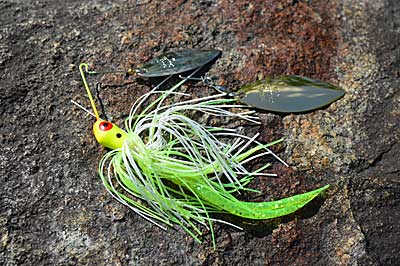
Reaching these spots requires a heavy 1/2- or 3/4-ounce spinnerbait with double willow-leaf blades, usually a No. 4 in front of a No. 4.5. These blades provide plenty of flash and vibration but not much lift, making it easier to fish your spinnerbait deeper. Your lure’s weight also helps it sink into the grass and stay there. You can add more weight to a spinnerbait by removing the center of a rubber-core sinker and crimping it on the hook shank directly behind the head.
The retrieve is straightforward. Cast your spinnerbait into or across a bed of aquatic vegetation, aiming it to come along an edge if possible, and let it sink into the top of the grass. It may take a cast or two to find the right amount of time it needs to reach the grass. Count off the seconds as it sinks, so the magic depth is easy to repeat. Revisit that number often to keep up with changing depths. Next, begin a slow retrieve, just fast enough to turn the blades. You want them to create enough lift to keep your spinnerbait moving horizontally but not too fast that it rises or too slow that it sinks.
Your spinnerbait will make its way into the grass, whether running into a taller clump or settling into it after pausing your retrieve. Once you feel the weight of the grass and blades stall, give your rod tip a quick twitch. That movement will immediately transfer to your spinnerbait through a no-stretch braided line. It’ll be enough to clear all the grass from your spinnerbait and restart its blades so that you can resume your retrieve.
You’ll need at least a 7-foot rod to handle these heavy spinnerbaits. The extra length also will help you make longer casts, allowing you to cover more of each spot with each one. Choose a reel that takes up a medium amount of line with each handle turn, about a 6:1 gear ratio. That will allow you to retrieve at a comfortable pace without rushing your spinnerbait, keeping it deeper. Spool it with 20- to 50-pound test braided line, depending on the size of bass and thickness of the cover.
Small Spinnerbaits In Shallow Water
The first few warm days of spring are a magical time. While most of the water in most lakes, rivers, and reservoirs remains cold, the shallows' temperature rises, thanks to more and more sunshine. It's a combination that's an irresistible draw to anglers. Bass like it, too, especially when there are docks, laydowns, and riprap.
Hard cover offers bass protection and ambush spots. It also provides slightly better conditions, absorbing solar radiation and releasing it as heat into the surrounding water. The temperature change is slight, a couple of degrees most days, so it won't attract bass from any distance. But it will make the ones that swim around it slightly more active and draw them to the top of the water column. It makes these cold-blooded fish more interested in what’s happening around them, though they aren’t ready to step out and jump on any lure that swims past. You need a compact lure to catch them.
While these shallow-water bass may eat a small crankbait or vibrating jig, slight spinnerbaits shine in this situation. Their blades lift them high into the water column and strike zone, and their single hook resists snagging cover. Ones that weigh 3/16- or 1/4 ounce are perfect. Match either to tandem blades. Try a No. 2 Colorado blade in front of a No. 3 Colorado, or follow a No. 3.5 willow-leaf blade with a No. 4 willow-leaf blade. Put a No. 4 willow-lead blade behind a No. 2 Colorado blade if you want the best of both worlds.
While its head contributes to a spinnerbait’s overall size, its weight plays a more critical role. It needs to be in balance with the blades. Spinnerbaits outfitted with big blades and a lightweight head turn over while retrieved. Those with small blades and a heavy head require a fast retrieve. While the latter can prove effective other times of the year, you must strike the perfect balance when fishing shallow water in spring.
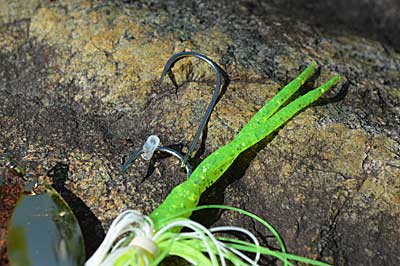
The style of blades you choose is based on the bass’ activity level and water conditions. Sluggish bass, or bass that swim in stained or muddy water, need help finding your spinnerbait. So, Colorado and Indiana blades are best. They move a lot of water, which you can feel by the way they make your rod thump, and slow your retrieve. On the other hand, Willow-leaf blades are better for warm, clear water. They are flashy, grabbing the attention of bass from further away, and can be retrieved faster.
There isn’t much room to work while zigging and zagging around shallow-water cover. So, choose a rod between 6 feet, 6 inches, and 7 feet long, making short and accurate side or roll casts easy. You'll want at least a medium-heavy power to pull big prespawn bass away from cover. But don't go too fast on the action. A tip that gives a little will quickly load on your backcast, helping you cast lightweight lures accurately. Add a baitcasting reel with a 6:1-gear ratio, which will help you keep a slow retrieve, filled with 12- to 15-pound stretch fluorocarbon or low-stretch monofilament.
Don’t Forget The Trailers
Spinnerbaits aren’t complete without a trailer or two. Soft-plastic trailers, such as grubs or split-tails, add a splash of attractive color and some bulk to your spinnerbait. Adding a 4- or 5-inch grub, for example, will slow down your spinnerbait's movement, horizontally and vertically. Be sure to rig it so the tail curls in the opposite direction of the hook. That will reduce fouling.
You'll need to add your soft-plastic trailer before adding a trailer hook. It'll catch bass that swipes at or short strikes your spinnerbait. It must be free-floating to remain in line with the main hook and not snag.
Trailer hooks slide over the main hook. You can keep it on there a couple of ways. Sometimes you can adjust the eye with a pair of pliers, narrowing its diameter so it won’t slip past the main hook’s barb. Or you can use a small section of surgical tubing or plastic disc. Cut the latter from a coffee can’s plastic lid with a hole punch. They’re small, so be careful while putting them on. A spinnerbait’s main hook is stout and sharp. A slip here can lead to big problems.


